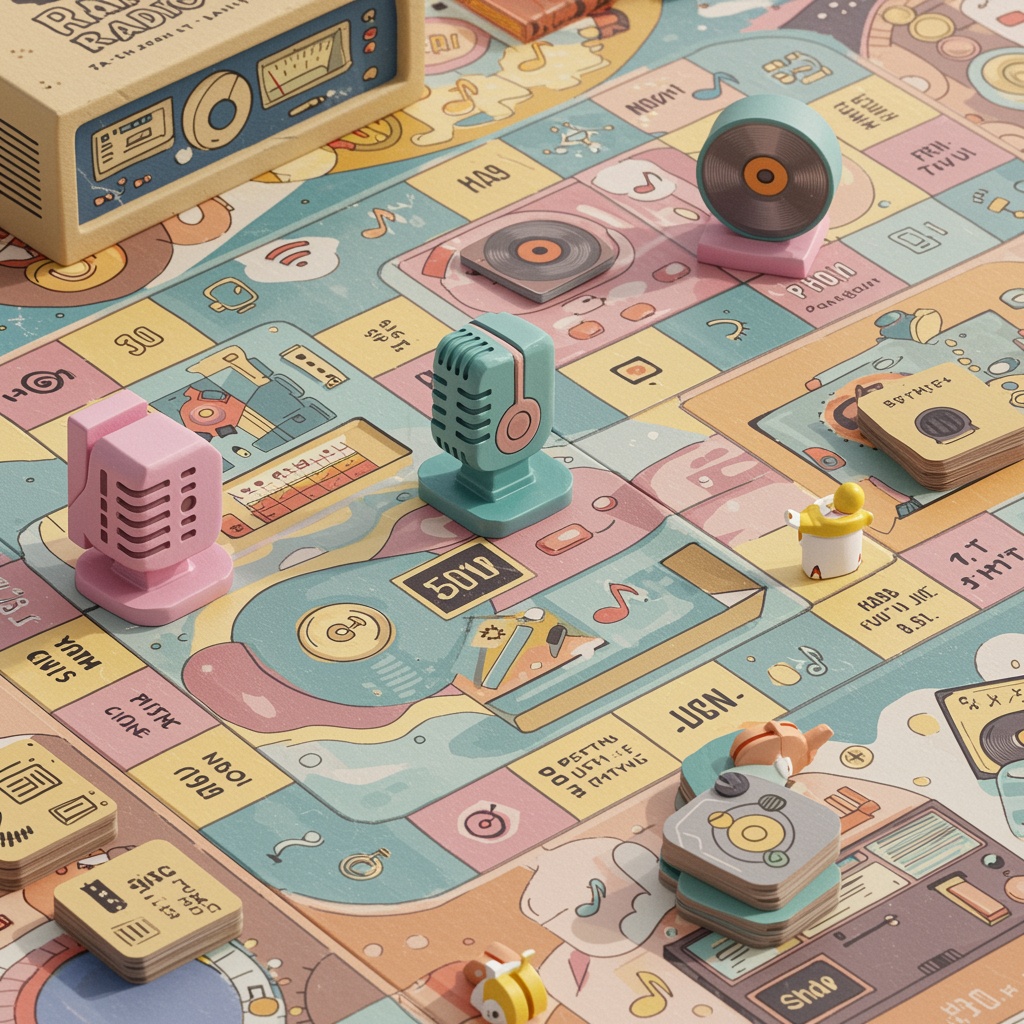
How spectacular was the matchup watched ’round the world last night? Did you stay tuned in until the end or did you bail out early? Did you watch (and rate) the scores of $8 million dollar ads, including the ones you either couldn’t understand or left you clueless about what they were trying to get you to believe or buy?
No doubt about it. The “Big Game” (as it is called for all of us who didn’t cut a licensing deal with the NFL) has been elevated over the years to become as big an event as many holidays on our calendars, even the ones that have been around for centuries.
For anyone still wondering why the athletes are so “overpaid” and why Fox’s average unit rate of $8 million for a :30 during the game is a higher average rate than your radio station is charging, stop making yourself crazy. Even a bad game like last night’s exhibition is watched intently by unprecedented audiences here in America and around the world. Any disgruntled mumblings of “It’s just a game” should be forced to retake a Marketing 101 class.
In our modern world, games of all kinds are a huge deal. We wager on them, argue about them, and of course, watch them in person and on TV. Fortunately, a lot of people still listen to them (and talk about them) on sports radio stations.
The trend in television is streaming – exacting a monthly subscription fee for the privilege of viewing a game that was once free of charge to watch. And then there’s broadcast radio where the play-by-play action is still free – at least for now.
And then there are games we play and our motivations for doing so. Games are configured in myriad ways – the ones we engage in solo or in groups, those that are timed and those we can play without a clock, etc.
There are a “lot of moving parts” when it comes to gameplay, and interestingly, a connection to what we do in radio. That’s illustrated by a brilliant Reuters article where they actually created a game readers can play that’s the foundation of the story.
“Cozy Comfort” was written and developed by Tiana McGee and Daisy Chung, along with a Reuters team. They collaborated to create a game you can interact with while reading the story about the impact games have on us. Conceptually and creatively, it is a truly nice piece of work and a rarity in the media world.

Their story – “Cozy Comfort” – is all about how consumers are using games to help adjust their attitudes and angsts. The piece is subtitled, “New research backs up what gamers have thought for years: video games can be an antidote to stress and anxiety.”
The Reuters game is an example of a subgenre gaining in popularity in recent years – “cozy games.” They tend to be relaxed, so called play-at-your-pace games that have shown widespread appeal.
As Reuters points out, “cozy games” exudes communities – not necessarily online groups like we see on sites like Facebook, LinkedIn, or Reddit. Instead, these “communities” are the worlds in which the games are set. The Sims game was a gaming community where you could interact with other characters.
It’s common for players to lose track of time and even space when immersed in these games – and as the Reuters story points out – that’s their charm. They whisk you away to a different world where you can lose yourself for moments of time.
And as Mike Stern pointed out to me when he sent me the story, that’s not dissimilar to what great radio stations were able to do – take you someplace else, adjust that attitude a notch or two, provide companionship, take the edge off, and maybe give you a smile or even a full-throated laugh now and again.
The Reuters team holds up a research study out of the University of Wisconsin-La Crosse that suggests “casual gaming” is as beneficial for one’s blood pressure and heart rate as “mindful meditation” in a group of student respondents.
Can listening to the radio provide a similar benefit? Probably not, but as our Techsurvey show year after year, there’s solid emotional benefit that comes with radio listening for many fans. Our “Why Radio?” chart points out a number of these using the round red E symbols below and the red bars:
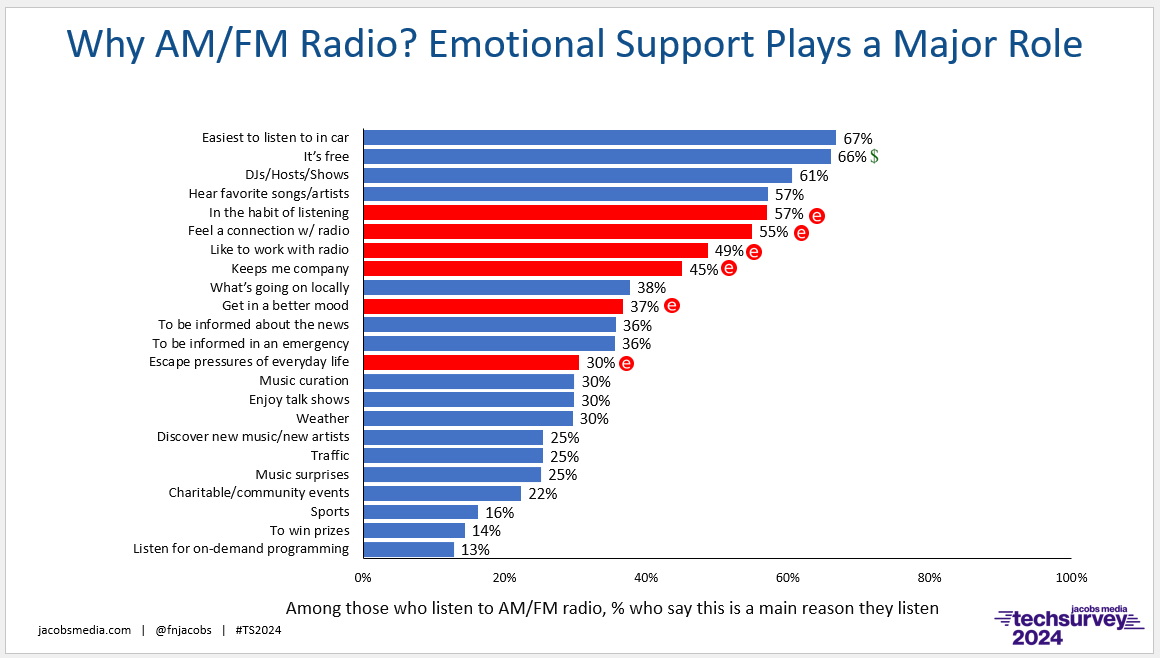
Mood elevation, keeping one company, connection, and even the comfort of habit are all factors mentioned by sizable groups of radio regulars in their explanation of what they derive from listening.
Beyond commercial radio, other platforms provide similar plusses but interesting differences as well. For Christian music radio, those attributes are on bold display each summer when we present that version of our signature survey we produce in collaboration with the Christian Music Broadcasters.
In addition to the usual values, our thousands of respondents in these CMB studies emphatically tell us of the spiritual boost they enjoy from listening to these stations. If you’ve wondered in recent years why these stations are proliferating while so many other radio formats are struggling, the chart below tells an important story.
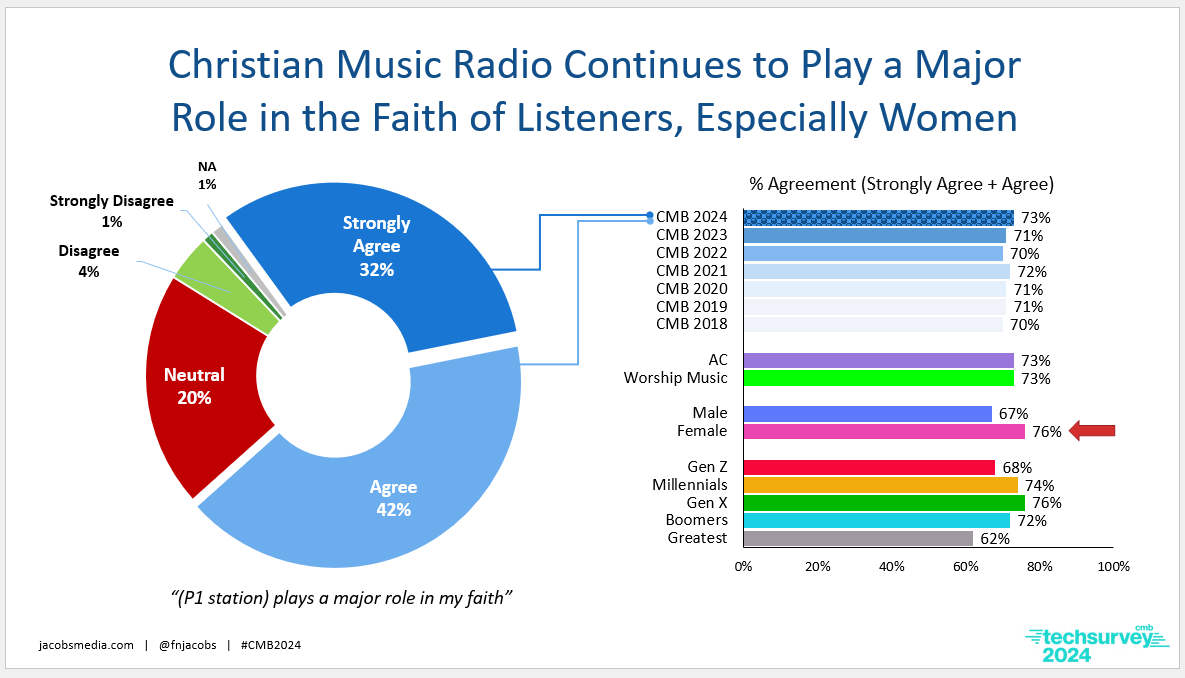
Before, during, and after the most cataclysmic events of our lifetimes – the COVID pandemic – Christian Music Radio has consistently brought millions closer to their faith. When seven in ten respondents concur with this notion year in and year out, it’s clear these stations are doing more than playing the hits.
What about public radio, a broadcasting platform facing unique and serious challenges decades after it was first established? These days, there are political and governmental speed bumps, revolving around funding, whether from Congress or the ways business, organizations, and foundations support these stations.
So from the standpoint of programming, how might a public radio station deliver on some of the same emotional values players get out of “cozy games?” And if you’re wondering why the “NPR News” stations in the system need to bother with lightening the mental loads its listeners and donors are facing, consider this:
More than one-fifth of core public radio fans express the need to take a hiatus from the rough and tumble news cycle. That emotion runs even deeper among the format’s news/talk fans, women, and the youngest listeners. And keep in mind this year’s PRTS survey was fielded over the summer, months before the results of the election and its aftermath:
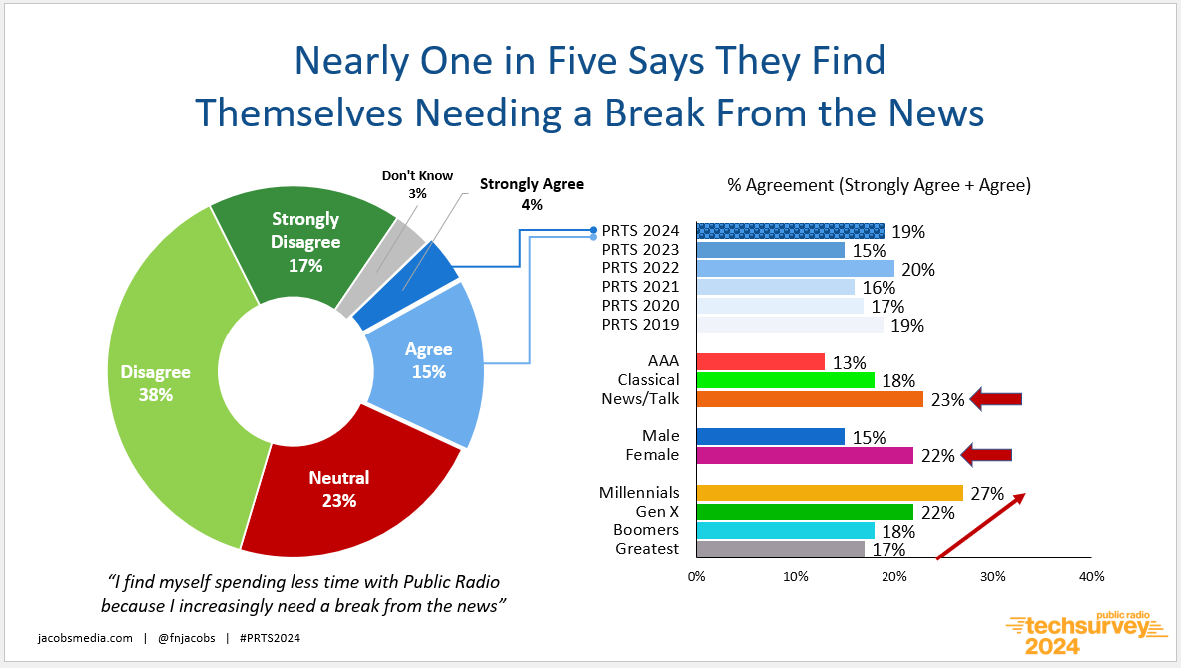
Public radio stations that specialize in music formats such as jazz, classical, and Triple A are very much in-sync with the types of emotional payouts ranging from escape to relaxation.
It’s public radio news stations that may come up short because so much of their content is centered on the super-serious events of the day – Congressional hearings, sprawling cease fire talks, mass shootings, and the other mind-numbing stories that seem infinite. It’s hard to find relief from all of that on radio outlets known for news.
Except the New York Times has perfected the ability of a hard news institution to deliver a respite to its readers – its growing “Games” division featuring addictive but relaxing diversions such as “Wordle” and “Spelling Bee.”
“Wordle” and “Spelling Bee.”
But they’re not alone. Public radio also has an impressive track record in transporting even its hardcore news fans to more whimsical and less hard news destinations.
Consider features like “All Songs Considered” and those quaint “Tiny Desk” musical performances NPR became famous for. And then there are those quirky news stories peppered into news magazines like Morning Edition and All Things Considered. That’s the storytelling public radio fans have come to appreciate, those “Driveway Moments” famous for keeping listeners in their cars to hear the rest of the story.
Finally, public radio devoted decades to pleasing its core fans and supporters with escapist weekend programming that provided relief from a steady lineup of news shows throughout the weekdays. Car Talk and A Prairie Home Companion were on top of this list, but neither exists any longer.

The last remaining franchise in this “cozy” category on public radio is the massively popular Wait, Wait…Don’t Tell Me! It’s NPR’s weekly quiz show known for not taking itself or its audience too seriously, providing a current events respite in much the same why CBS Sunday Morning and Saturday Night Live provide on the networks that carry these shows.
While weekend programming isn’t going to turn around the content, financial, or political dilemmas now faced by many of America’s public radio stations, an exciting, new, upbeat show capable of lifting up the collective spirits of their audiences at a moment in time where it’s never been more critically important.
Game creation by a radio station may not be the elixir to turn around an onerous news cycle but it could be a start. WHYY, the public radio station in Philadelphia, has developed a game its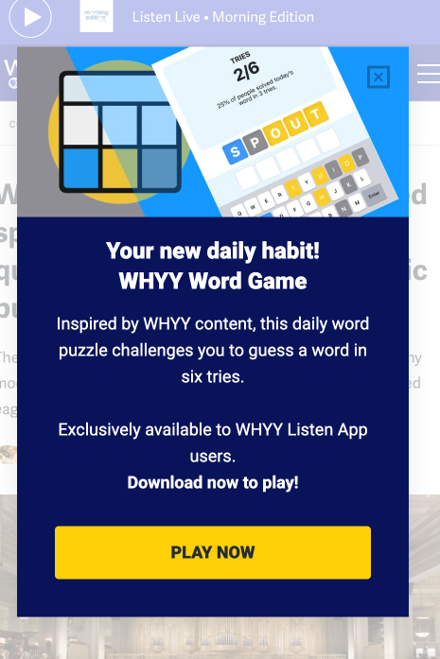 audience can play on their mobile phones.
audience can play on their mobile phones.
It’s not perfect but it’s a start. And from it, WHYY will learn more about this segment of its audience – news junkies that just need a mental breather now and then. As the times we live in get even more rugged, these pressure valves might become important solutions, even though they’re temporary fixes.
The “cozy game” trend might not be isolated to the video game platform of entertainment. Instead, it’s not hard to conclude that any medium charged with meeting the audience where they are mentally might want to focus on its emotional deliverables in 2025.
There’s a lot for radio programmers and strategists to be mindful of in this still new year. And I would conjecture emotional levels among the audience may be running hot, especially given an increasingly contentious political landscape, not to mention some of the weather and environmental crises many have already faced in the new year.
Emotional delivery isn’t an abstract concept, but it isn’t likely to show up in Nielsen ratings or on streaming reports. To create a clearer ascertainment of audience (and advertiser) needs, stations are going to have to work a little harder to determine how these conditions might be affecting specific markets and discreet audiences. Your mileage will vary, so do your due diligence.
In 2025 radio, questions run deeper than “How’s your cume?” or “What are you margins?”
You might be the wiser to take the audience’s emotional temperature before the year gets away from us.
Of course, the team at Jacobs Media is focused on “all of the above.” We’re watching the returns roll in from Techsurvey 2025, and we’re forging appropriate strategies and tactics for 2025. We’d be happy to talk about this and other ways we can help your station grow. Please check in with me or Paul. – FJ
- It’s The Christian (Radio) Thing To Do - June 3, 2025
- Is It Time For Radio to WAKE UP?! - June 1, 2025
- For Radio, The Perils Of Rebranding - May 30, 2025




As always you’ve come up with a pretty unique approach of getting the listener involved, Fred. Back in the day our first Top 40 station came on the air with “Radio Bingo”. Printed cards would show up at local retailers and you’d follow along as the songs listed on the “bingo card” were played. Once the bingo card was “complete” the first caller would win $50. (This was 1958.) Fast forward to 1978 and the same concept -tried again, only with me on the station end. No one could predict the ramifications. Listeners calling during every song ’cause they didn’t “hear” the title/artist. Jocks slowing down their approach in hopes that the phone wouldn’t ring again. It was pretty disruptive because we never really thought it through. In 2025 stations could enlist technology to do something similar with an app. (Hold your phone up to the speaker and the app will fill in the song automatically.) The “text to win” or “keyword” promotions are okay. . . but jeez how exciting are they? Radio can be so much more creative with some foresight into how the listener can get involved. Thanks for pointing it out.
Glad it resonated for you, Dave. Thanks for the comment.
This is one of your best ideas in a sea of really good ones. Radio could brand a white labeled game or flat out invent its own and it could be huge revenue opportunity. Most don’t know that airlines don’t make much money flying anymore, but earn their money on credit card fees. This could be the same idea for radio. And gaming turns out to be another one of those things we were always told was bad for us that turns out to be good. Maybe I should go get a lapdance – its only a matter of time…
As always, Bob, you’re whirring away on an idea deserving of more time, attention, and brain cells. There’s got to be more than this race to the bottomo selling :30s and :6os.